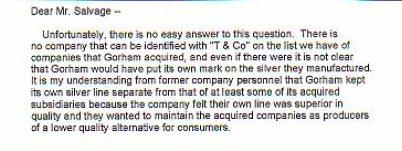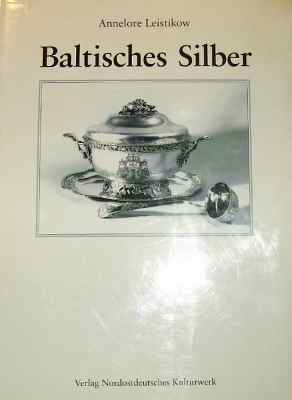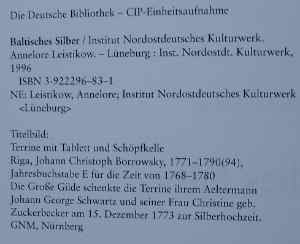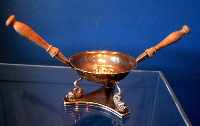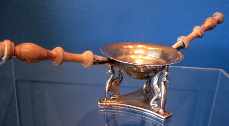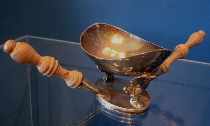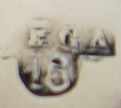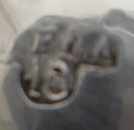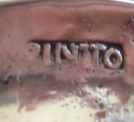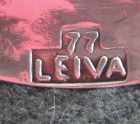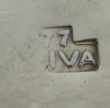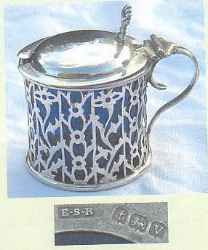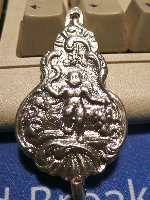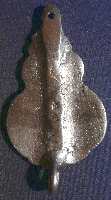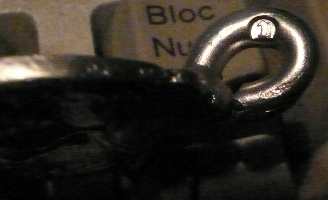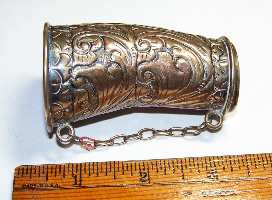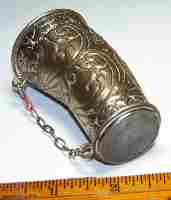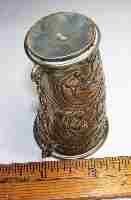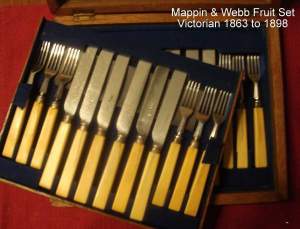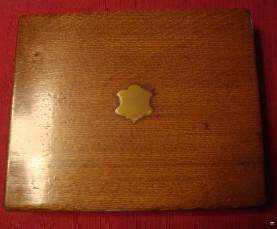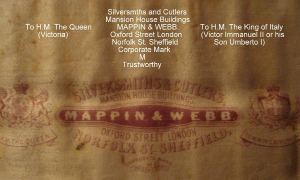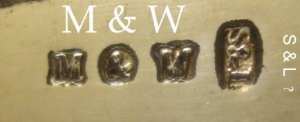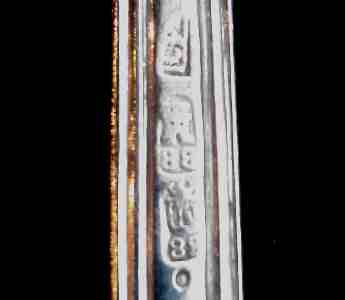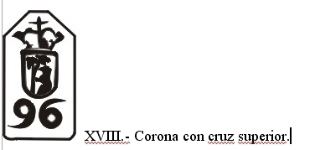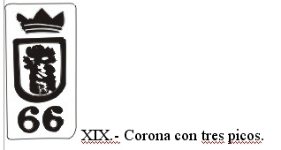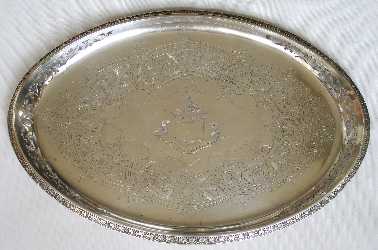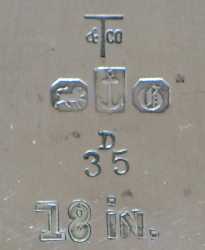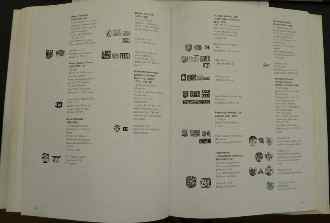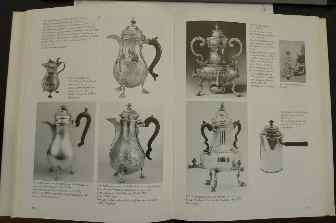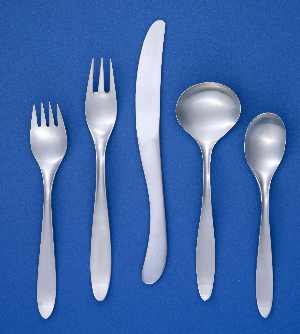
Dorothea Burstyn presents:
Don Wallance, a leading flatware designer and Amboss,
an innovative Austrian flatware manufacturer. Two
interesting lectures at the Solingen flatware collectors'
meeting 2010 
.....This year's flatware collectors meeting at the
Solingen Klingenmuseum, planned and executed by director
Dr. Barbara Grotkamp-Schepers with her usual energy and
charm, was again a complete success. This year's motto
could have been "The productive 1950s-70s", as Dr.
William P. Hood Jr. spoke about Don Wallance and Jörg
Müller-Daehn presented his and Heinrich Averwerser's
research on the output of Ambosswerke, Austria, in the
same time period......
click here 
|
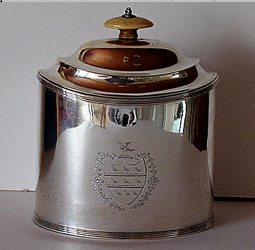
David McKinley presents:
The Early History of The English Tea Caddy 
.....Although it is believed that Thomas Garway (or
Garraway) first served tea in his coffee house in London
in about 1658 it did not become widely accepted until
after the 'Restoration' when it was popularised by
Catherine of Braganza, who brought the tea drinking
habit with her from the continent.....
click here 
|
Welcome to new ASCAS members:
Mareshah Bowie - Australia
Vaughan Clark - England UK
Rupert Fairfax - England UK
John F. Ingram - England UK
Jean-Gabriel Lamorte - France
Silvana Melis - Italy
Peter Sargent - Germany
C.Ann Sorrell - USA
Ron Travis - Australia
Members' Window # 72
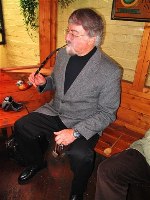
RevDr. John Wade Long, Jr
and Giorgio Busetto present:
Smoking a 160-years-old pipe 
I'm attaching several photos of one of my very special
pipes, a 160-year-old meerschaum "Kalmasch" (German
style) carved in Vienna with the silverwork done in
London. It also has a sterling silver safety ring on the
shank for the smoker to slip his "pinkie" finger
through - in the event the bowl accidentally detaches
from the stem.....
click here 
|
Sandra Schreiber writes:
...I am going crazy trying to figure out what these are, where
they are from, and how old they may be. Obviously, they are not
matching, and may have been part of a collection. They are all
marked, but the marks are poor, and virtually unreadable: I
would guess that they are made to drink out of, possibly....otherwise
why the handles?
There is no way to heat anything as there is no element below
the bowls. My guess is that they are South American. The silver
is probably not 925, but more like 900 or 850.... One of the
marks on one of the items has a "77" with"??IVA" maybe, and
another one has an "18"...with maybe "uRA"and one "PINTO"
perhaps.
Any help would really be appreciated! The color is silver
although tarnished, not this coppery look in t he photo, which I
can't explain!
Many thanks,
Sandy Schreiber,
Your items are, simply, three braziers (or ember bowls or
pipe lighters). They were made in Spain or South America.
More information is available in my private website at
http://www.silvercollection.it/dictionarypipelighter.html or in ASCAS web site at http://www.ascasonline.org/window1.html
Giorgio Busetto
These braziers were definitely identified as Spanish by José
Luis Muñoz. These are the details:
BEGA/18: year 1818.- assayer of the town of Córdoba, Diego de
la Vega y Torres (active from 1805 and from 1814 to 1821)
PINTO: this is a maker's mark of an unidentified silversmith
77/LEIVA: year 1777 - assayer of the town of Córdoba, Juan de
Luque y Leyva (active from 6 November 1772 until 1780). José
Luis Muñoz
Simon Buxton writes:
...I don't know whether you consider discussion of silver plated
items to be outside the group's interest, but if not I wonder
whether you or your members can help me via a future newsletter.
I am trying to classify the British letters used to identify the
different silver plating processes used during the middle of the
19th century when electroplating and the use of German/Nickel
silver became available and was replacing earlier methods such
as Old Sheffield plate (OSP) and Close plate. In general makers
using earlier processes never identified the process employed
and those pieces that were marked were limited to names or
symbols identifying the maker. However from around the mid 1830s
to around 1860 letters were quite often used to indicate the
process used. Some such as EP or EPBM are well known and
documented while others are less often found and it is these
that I would like to find out more about, especially the process
employed and/or the period in use. I list below those marks with
the little information I have and hope others can add more
details.
MP (Magnetic plating) - Prime introduced an electroplating
process in the mid 1840s which avoided Elkington's patents by
using a different electrolyte and power source. Goods were
marked MP for about 5-10 years. Does anyone know more precise
dates?
PGS (Plated German silver) - I have seen this used on one Old
Sheffield plate piece to signify plated on GS rather than copper
Can anyone advise which processes used these letters and for how
long?
PS (Plated steel) - stamped on some Close plated items, probably
after electroplating had begun. This raises the question as to
when Close plating virtually ceased, perhaps around the same
time as OSP around the 1850s.
WP (White metal plated) - seen on a fish slice with pseudo
hallmarks that was probably close plated on German silver. Again
which processes used WP and over what period?
Regards
Simon Buxton
A fascinating and little known matter. Some of these
initials (EPNS, EPBM, EPCA, EPGS, are illustrated in my website
at
http://www.silvercollection.it/electroplatesilverEHdue.html
By the way, the WP into a lozenge with pseudo hallmarks was used
also by William Page & Co (see at
http://www.silvercollection.it/electroplatesilverNOPtre.html )
Any further contribution will be highly appreciated.
Giorgio Busetto
Mario Galasso writes:
...I'm researching any possible information about the origin of
this chatelaine and its mysterious mark (a 1?).
Any suggestion will be highly appreciated
Mario Galasso
Lisanne writes:
...My question is about an item that I found and although I have
searched online and asked many people on different forums, no
one can identify it. I so hope that your vast knowledge will be
able to help me know what this item is.
It is about 2 7/8"Long, the diameter at the top is 1 5/8 and the
diameter at the base is 1 1/4". As you can see from the pictures,
there is a small linked chain that goes from the top to the
bottom. There are no makers marks present and the only thing it
reads on the bottom is "800".
I hope that I have not offended you by asking my questions, and
if so, I apologize in advance.
If you do know what this item is, I would truly be so
appreciative, since no one knows what this is!
Many thanks,
Lisanne
Any idea by ASCAS members?
Giorgio Busetto
Jayne Dye writes:
...I have a Mappin & Webb fruit set for 12. The marks are M&W
S&L.
It has bone handles and silver plated blades and bolsters (the
ringed piece attaching the blade to the handle).
My requests of other members are
(1) perhaps a closer estimate of the year of manufacture
(2) the interpretation of the S&L mark
In Giorgio's silvercollection.it, I found this chronology
Mappin & Co 1859-1863
Mappin & Webb 1863-1898 (purchased Stephen Smith & Son, 1886)
Mappin & Webb Ltd 1898-1906 (absorbed Mappin Brothers 1902/1903)
Mappin & Webb (1908) Ltd - 1908-1913
Mappin & Webb Ltd 1913-present
This documents that the stamp Mappin & Webb (without Ltd.) was only used in the
period of 1863 to 1898. This dates my set to the
final quarter of the 19th century.
I would like to narrow it down to a shorter span if possible.
There is an [S&L] mark that I do not understand. I have not been
able to identify it.
There were M&W outlets in Sheffield and London. Could the mark
refer to those two locations? It seems unlikely a company would
have a punch made for what seems to be trivial information.
Opinions are sought. Does a reader have a more useful
interpretation of the S&L mark?
Thank you, (Click on pictures to enlarge)
Jayne
It is difficult to narrow the date of your fruit set.
There is little information about the date of use of silver
plate marks and, in many cases, the same mark was maintained for
a long period.
I'm working on a wide directory of English electropate marks (see
http://www.silvercollection.it/electroplatesilver.html ) and
I well know how difficult is to obtain this information (by the
way Mappin & Webb used a sort of date letter in some of its
items but I was unable to find the information necessary to
decode these dates).
I agree that your fruit set was made in the last quarter of the
19th century, before the death of Queen Victoria (1901: in your
image is quoted the queen) but I'm unable to restrict the date.
About L&S mark: I believe that it refers indeed to London &
Sheffield. It was a common practice for silver plate makers to
use a letter to indicate the town. If you visit my directory you
can see many marks with S (for Sheffield - but in some cases it
signified Son or Sons), G for Glasgow (William Alexander at
http://www.silvercollection.it/electroplatesilver.html ), M for
Manchester (Arnold & Lewis http://www.silvercollection.it/electroplatesilver.html
) and some others. This practice was scarcely followed by
Birmingham makers (I don't remember any mark with B).
I trust in some other contributions by ASCAS members.
Giorgio Busetto
Replies to questions
Michael Carter
receives this reply about the mark of his spoon
(see April 2010 Newsletter)
José Luis Muñoz writes:The mark on Michael
Carter's spoon is Spanish, and precisely a mark of Madrid. The
coat of arms of Madrid is represented by a bear and a
tree. The image's quality does not allow further identification as
to whether the mark refers to the 18th or the 19th century.
The two marks differ in the shape of the crown above the shield
José Luis Muñoz
Caroline Padavano S.
receives this reply about the mark of her Gorham tray
(see March 2010 Newsletter)
Les Salvage writes:I add a comment about the tray
showing Gorham's full marks for their sterling silver (except
from the fact that the word 'Sterling' was missing). I contacted
John Hay Library, Providence, Rhode Island, USA, for assistance
as to the name indicated by T&Co, and I attach a relevant
extract from their reply.
From this, I deduce that T&Co in 1871, represented a Company of silversmiths who
had been taken over by Gorham, and that the tray was not silver plated,
hence Gorham's full marks
were struck except for 'Sterling'. It seems reasonable to
suppose that by this method, Gorham was adding value to T&Co's
tray by virtue of the fact that the general American public at
that time, were expected to believe that the anchor represented
a Birmingham (England) mark and thus generated sales which otherwise
would not have happened.
Gorham, on this assumption, wanted their subsidiary to prosper,
albeit in a lower class of silver excellence than their own. The
omission of 'Sterling' differentiated from Gorham's practice of
always striking 'Sterling' on their own silver.
It will be noted that the lion passant on the tray is facing to the right,
whereas the Birmingham (England) lion is always facing left. This would probably
not have been noticed by the general American Public, plus the fact that
a genuine Birmingham mark would not have included 'Sterling' and Gorham
has left this off.
Gorham used a left facing lion passant prior to 1865. Also, a right facing lion rampant,
circa 1850 - 1865.
You may also be interested to know that in the PATENT number 2854 of 31 December 1867
John Gorham declared that the trade mark "anchor on a shield" (not associated to
lion and "G") designated and
distinguished the genuine manufacture or article of "electro plated ware"...
Les Salvage
P.S. We can safely state that the T&Co on the tray does not represent Tiffany & Co.
This company always showed their full name on their silverware when there was room for it.
This also was the case when Gorham made items for Tiffany. When jewellery was made by Tiffany,
they used just 'T & Co' (not stylised as per that on the tray)
"A PAGE per MONTH"
In this column we present a page
obtained from makers' brochures, books, auction catalogs,
advertising or whatever other printed paper, related to silver,
that may be of interest for ASCAS members.
The images will be published at a "low resolution" level and for
private and personal use only
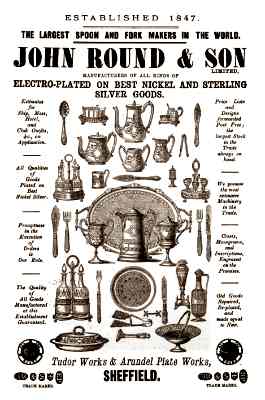
|
This month we present an ancient advertisement of
JOHN ROUND & SON
Manufacturers of all kinds of
ELECTRO-PLATED ON BEST NICKEL AND STERLING
SILVER GOODS
The firm was established by John Round in Sheffield
in 1847 as a small family workshop attached to his
house in Tudor Street. The business proved successful
and the firm in partnership with his son Edwin went
under the title of John Round & Son. In 1874 the firm
became John Round & Son Ltd and in 1886 the business of
Ridge, Allcard & Co (Lions Works, Eyre Lane) was
amalgamated and John Ridge became the manager. The main
factory was the renewed Tudor Works, Tudor Street,
Sheffield while various showrooms operated in London.
|
"A WORD per MONTH"
In this column we
present an abstract from a page of the "What is? Silver
Dictionary"
courtesy of

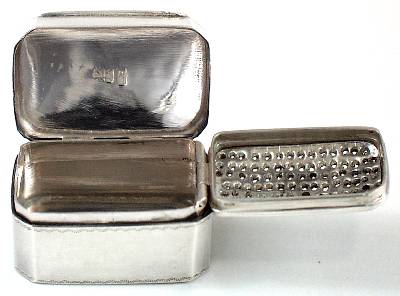
|
NUTMEG GRATER
The
nutmeg grater is an implement for grating nutmeg used
principally during the period 1780-1840. There were two
types: portable or table type. The systematic production
of silver graters for nutmeg began in the late
18th century. A revolution in manners then
gripped colonial America, as sophisticated Britons on
both sides of the Atlantic began serving punch - a brew
of rum or brandy, fruit juice, sugar, and water laced
with grated nutmeg and sugar - and a nutmeg grater
became an essential addition to the ' punch equipage
'....
more
|
"A SILVERSMITH per MONTH"
In this column
we present marks, information and history of silversmiths and
silver manufacturers.
This column is published under the kind permission of Giorgio
Busetto's website 
|
|
EDWARD BARNARD & SONS LTD
and its predecessors:
ANTHONY NELME - FRANCIS NELME - THOMAS WHIPHAM - WHIPHAM
& WRIGHT - CHARLES WRIGHT - HENRY CHAWNER - THOMAS &
WILLIAM CHAWNER - CHAWNER & EMES - JOHN EMES - EMES &
BARNARD - EDWARD BARNARD & SONS
Possibly the oldest
manufacturing silversmith in the world, the origin of
this business having been established by Anthony Nelme
c. 1680. Francis Nelme succeeded the business on the
death of his father in 1722 and continued until 1739
when Thomas Whipham took over the business....
more
|
"A BOOK ON MY SHELF"
In this column we present books, new
or ancient, dealing with silver in all its aspects (history,
marks, oddities...). This isn't a "book review" but only a fair
presentation of some useful "tools" that anyone may have in the
shelf of his bookcase.
ASCAS members are invited to contribute to this column
(click to enlarge images)
The "book on my shelf" of this month presents (courtesy
Postnikov):
"A CREST per MONTH"
In this column we present images and
descriptions of Crests and Mottoes of British, Irish and
Scottish families as engraved on silver items.
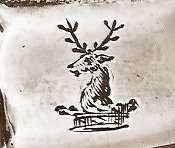
|
FREND or FRIEND
Frend: a family in the County of Limerick.
A buck's head. Motto Aude et prevalebis
(Dare and you will prevail).
The crest is engraved on a tankard, hallmarked London
1811, silversmiths Rebecca Emes and Edward Barnard I
|
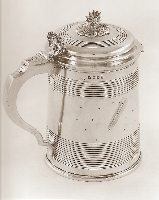 |
Closing our May 2010 edition of ASCAS
Newsletter I hope you have appreciated its content.
Your comments, suggestions and advice will be of great help.
My thanks to Dorothea Burstyn,
Simon Buxton, Jayne Dye, Mario Galasso, Lisanne, RevDr. John
Wade Long Jr, David McKinley, José Luis Muñoz, Postnikov, Les
Salvage, Sandra Schreiber, for their invaluable contributions.
Giorgio Busetto
Secretary
DISCLAIMER AND PRIVACY POLICY
ASCAS is a community of people having a common
interest in antique silver.
It is a non-profit association without commercial links.
Membership is open to whomever has a true interest in
this subject matter.
ASCAS has no real property and no fees are requested nor
accepted from members.
ASCAS keeps in touch with its members only through
periodical newsletters, e-mails and web-site updating
and ignores and is not responsible for any other
activity pursued by its members.
Likewise, ASCAS is not responsible for opinions,
evaluation and images displayed, and in any form
published or supplied for publication, by its members
who, in any case, maintain the property of their works
and assure the respect of national and international
legislation about Intellectual Property.
ASCAS does not have the full addresses of its members (only
town, country and e-mail address are requested for
membership).
ASCAS handles and protects with care its members' e-mail
addresses, will not disclose the addresses to third
parties, will use this information only to reply to
requests received from members and for communications
strictly related to its activity.
These rules are expressly accepted by submitting the
membership request.
|
|
 newsletter
# 72 MAY 2010
newsletter
# 72 MAY 2010
